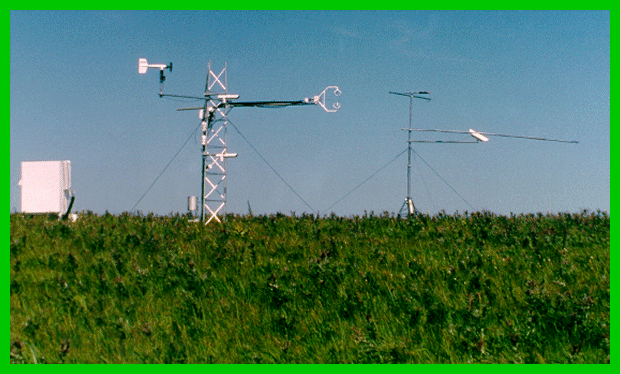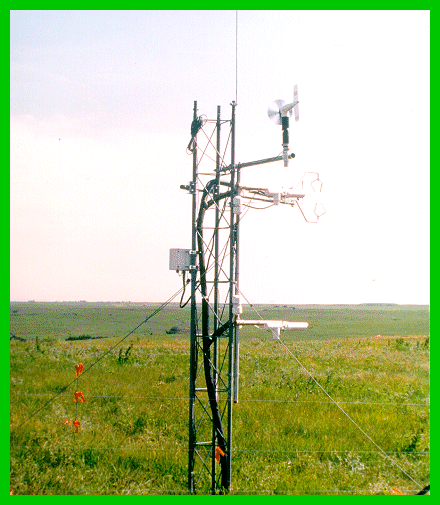

Landscape-Level Trace Gas Fluxes on Grazed and Ungrazed Tallgrass Prairie
Clenton Owensby, Jay Ham, Alan Knapp, and Lisa Auen
Kansas State University
Project Summary
For a slide presentation select (SLIDES). Three-yr. summary slides are also available (SUMMARY SLIDES)
We used conditional sampling (relaxed eddy flux stations) to obtain landscape-level carbon and water vapor fluxes on grazed and ungrazed prairie and will utilize those results to extend experimentally-derived information from research conducted over the past nine years which examined the effect of elevated atmospheric CO2 on a C4 ungrazed tallgrass prairie. Data from replicated chamber studies clearly showed that the primary impact of elevated CO2 was a reduction in stomatal conductance and reduced canopy transpiration that impacted soil-plant water relations. Water savings under elevated CO2 delayed the onset of water stress and increased plant productivity. Any environmental or land management factor that affects the ecosystem's soil-water balance will likely alter spatial and temporal dynamics of surface-atmospheric CO2 and water vapor exchange. A primary goal of research with elevated CO2 is to quantify carbon sequestration for the major terrestrial biomes. Our previous work has shown increased soil carbon in tallgrass prairie soils under elevated CO2. In order to scale those results to the landscape, we must measure the exchange of energy, water, trace gases, and biotic materials between the atmosphere and the terrestrial environment in real-world settings, which include exposure to fire and/or long-term grazing pressure, which are typical in grasslands across the globe. Thus, there is a question as to how to extrapolate the results from the chamber studies to the landscape or field scale, and how elevated CO2 might impact carbon storage in the presence of fire, grazing, and natural fluctuations in the environment. The objectives are to:
Relaxed eddy flux stations are being used to obtain continuous surface-layer measurements of CO2, water vapor, and energy fluxes on tallgrass prairie near Manhattan, KS. Fluxes are currently being monitored under two different land-management regimes: (1) burned annually, not grazed and (2) burned annually and grazed intensively-early in the growing season. A third treatment will be (3) burned annually and grazed over the entire growing season. Soil-surface CO2 fluxes will be measured periodically throughout the season. Supporting plant, soil, and physical measurements at each site will be used to help determine the key mechanisms regulating fluxes. Results will be evaluated in conjunction with other existing studies operated by the PIs (e.g.,LTER, NIGEC, NASA) to examine how multiple environmental and anthropogenic factors interact to govern terrestrial C fluxes. Data will be made available to other scientists for use in model development, scaling, and remote sensing studies.
Initial results in the 1997 growing season indicate that there is a significant reduction in carbon acquisition on grazed compared to ungrazed, particularly from the onset of growth until mid summer. After that time there appears to be a greater capacity to fix carbon on the area grazed heavily until mid season and ungrazed thereafter. Apparently, the newly emerging leaves have a much greater photosynthetic capacity. Figure 1 and Figure 2 provide a summary of the data from mid summer until frost in 1997.
Soil-surface CO2 fluxes Figure 3, biomass (Figure 4), and LAI (Figure 5) for the 1998 season.


Return to KSU Range Page